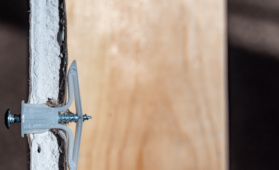How to Patch Jeans: Fix Ripped Jeans Quickly & Easily

There are two basic principles to the ManMade approach to style and dress: fit is everything, and buy high-quality, universal items that will last. In order to help you hold on to those investment items, and make sure they suit you as best they can, ManMade is happy to present our latest series: The DIY Tailor. This summer and fall, professional tailor and alteration specialist Danni Trester will teach us some basic sewing principles and easy DIY repairs that every guy should know.
It happens. To all of us. Suddenly your favorite pair of jeans, that you’ve worn in just perfectly, gets a blowout and you’re absolutely gutted. But have no fear! You can give new life to old friends with this pictorial guide on how to repair holes in your jeans!
This technique can be applied to any garment, fabric, or hole size. It’s no magic bullet – the stitching will be visible and it won’t look like new. But if you match your thread and fabric correctly, you can camouflage and reinforce the damaged area to give the garment longevity.
Gather Your Supplies
1) For this task you’ll need:
- matching thread
- scrap fabric
- lightweight fusible
- scissors (or a pinking shears if you have a pair)
- sewing machine that can also sew in reverse (some really old machines can’t),
- Iron and ironing board.
If you’re not sure what fusible is, it’s a lightweight non-woven webbing that when ironed between fabric, holds two pieces together. This will be used to hold your scrap fabric to the back of your hole so you can stitch it.

How to Patch your Jeans
2) To make things a little easier, and to be sure you don’t cut into any other part of the garment, put the item of clothing around an ironing board.

3) Cut off the frayed edges of the fabric so you have a clean edge. This will make it easier for the scrap fabric you’re stitching on to blend into the rest of the garment.


All cleaned up:

4) Turn the garment inside out and lay back onto the board. Cut your scrap fabric large enough to cover the damaged area and a little extra to extend into an unworn part. You may find you’ve got a pretty large piece if the fabric around the hole is also worn. You should reinforce any weakened areas too because if you don’t, they’ll be the next to get a hole.

5) Tear off little bits of your fusible to make a ring around the hole. Be careful not to get any over the edge, or you’ll see it on the outside.

6) Center your scrap over the hole, careful not to get too much on one side or the other.

7) Once your fabric is centered, iron the backside of the scrap. Use the steam setting, and hold it for a few seconds to make sure the fusible adheres.


8) Once you’re fused, it should look something like this:

Now let’s sew!
9) Set up your machine with a matching thread. A lot of times with jeans, or worn fabric, you may need a lighter color for the more worn areas, and a darker color for the less worn. If you have a limited selection of thread, or you’re not very particular, the same color for all is fine. But if you’re really trying to make it blend in, you can change the color part of the way through. For this demo, I am starting with a lighter color and switching to a darker one.

10) Change your stitch length to a shorter length. Not too short that you’re sewing in one spot, but not so large that it can easily be worn loose. Turn your garment inside out. Starting on the outside of the hole, sew forward until you’re on the inside of the hole, on the scrap fabric. Hold your reverse button and stitch back to the point where you started. Repeat this action, going back and forth. As you’re sewing slightly pull the fabric to the side so that as you are sewing forward and backward, it’ll start to form a zig-zag (NOTE: I don’t mean to use the zig-zag stitch on your machine. You’ll be using the regular straight stitch, but the back and forth motion will create a zig-zag shape). Go around the entirety of the hole, pivoting at the corners.

11) Once you’ve gone all the way around, stitch around the perimeter of the hole to tack down any loose fibers. You can do little back and forth sewing here too, just don’t pull the fabric to make the zig-zag.

12) Now that I’ve stitched the lighter color, I’m switching to the dark to stitch the less worn areas.

Pivoting at the corner:

13) Once you’ve stitched everything, turn your garment over and snip the extra threads off the front and back. Note the stitching pattern: zig-zag around the perimeter, tighter stitching around the edge of the hole.


14) If the scrap fabric didn’t get totally stitched down, trim off the excess fabric so that it doesn’t curl up as the garment is washed and worn. A good way to keep the fabric from unraveling is by cutting the scrap with pinking shears. If you don’t have one of these, scissors will work fine, you just will have more fraying of the scrap fabric on the inside.



Pinking shears:

23) While your garment is inside out, press the fabric to smooth out the stitching.

24) Turn the garment right side out and press the outside of the area.

Clip any extra threads that may have come loose as you were working.

Close up of the stitching:



You did it!

Danni Trester is a tailor with over 11 years of experience. She is currently located in Rochester, MN. In addition to alterations, she is a designer and shoemaker.









